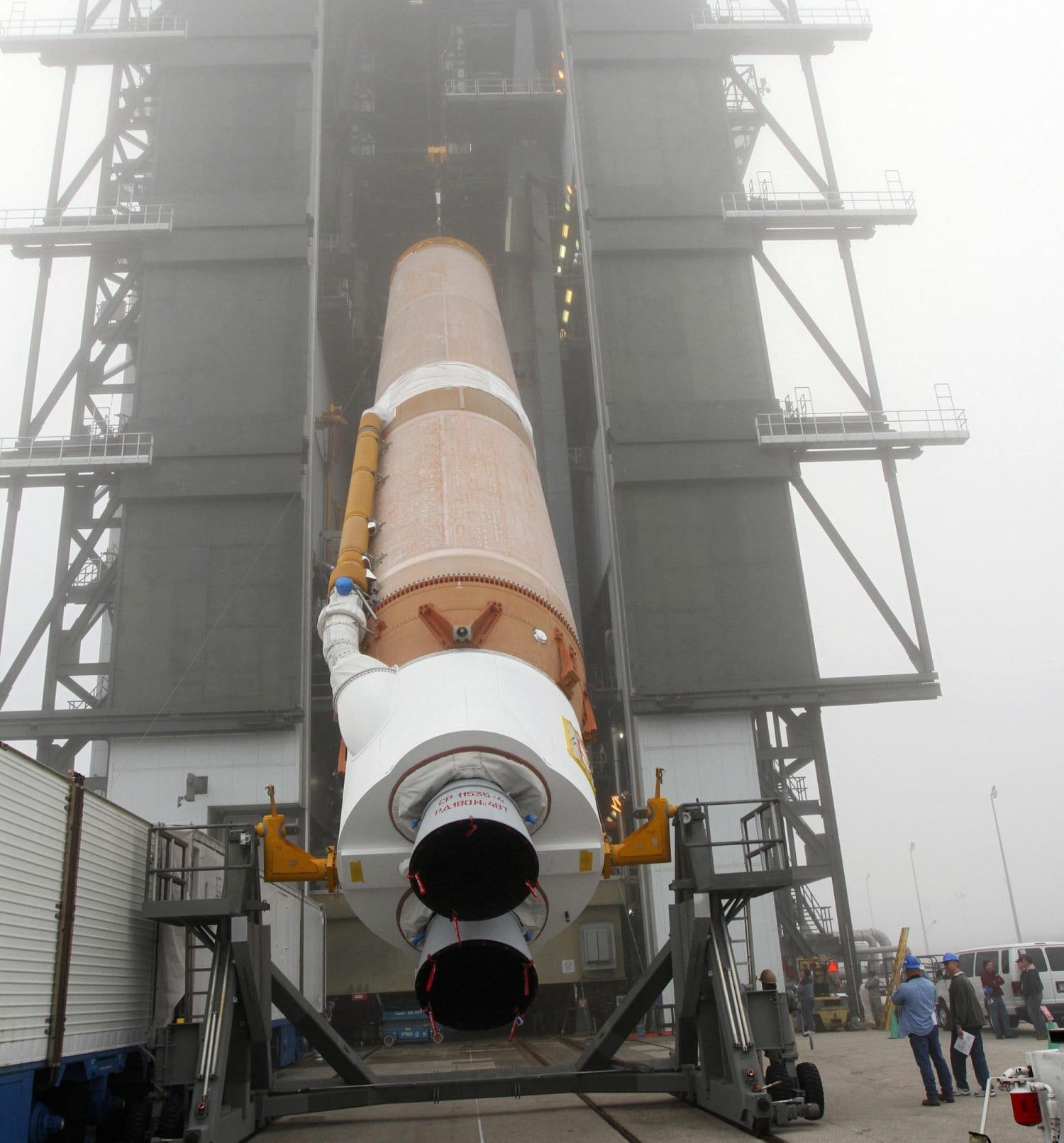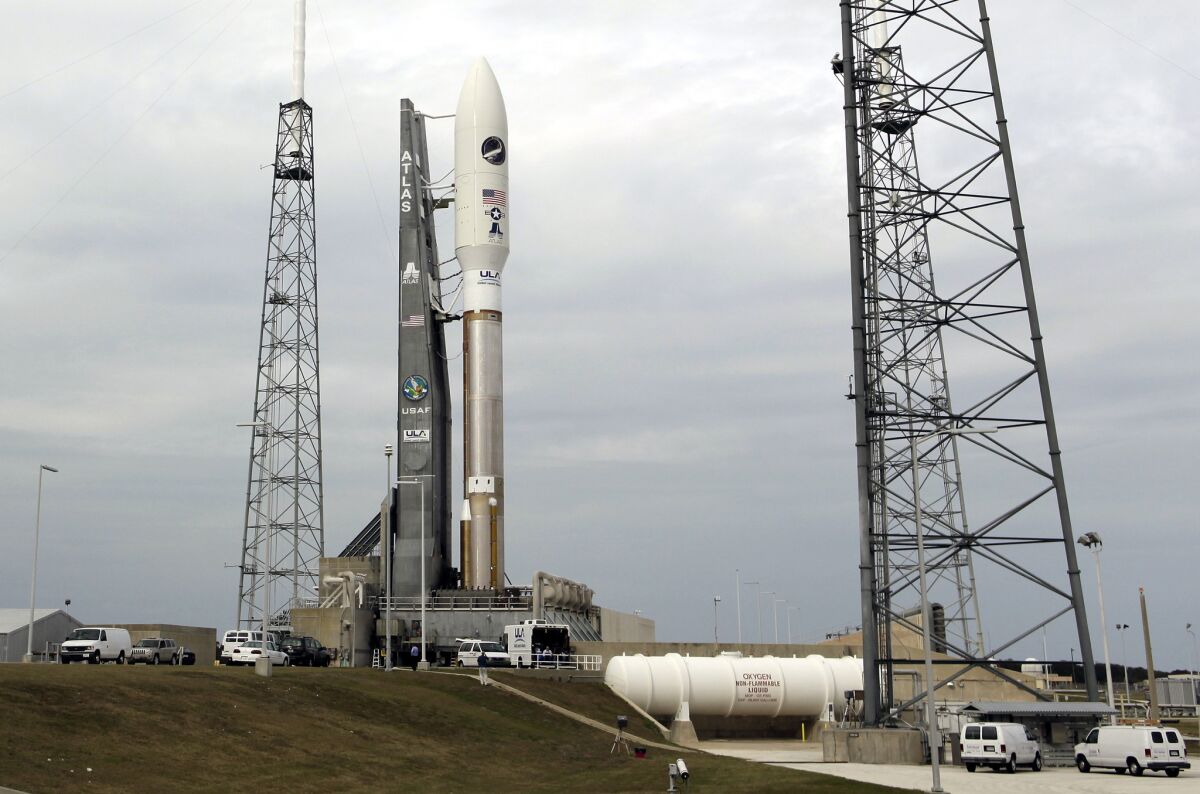Atlas Rocket Engine - The RD-180, (Russian: РД-180, Ракетный Двигатель-180, Raketnyj Dvigatel-180, Rocketmotor-180) is a rocket engine designed and produced in Russia. The RD-180 is a development of the RD-170 and is used as the main engine for the first stage of the Atlas V rocket being built by United Launch Alliance. The engine is manufactured by NPO Energomash, the American Rocketdyne was also involved in the development.
RD-180 is a liquid fuel engine and works with a closed combustion cycle. RD-180 is basically "half" RD-171, with two instead of four nozzles and one preburner instead of two. The two turbo pumps are driven by a single gas turbine, which has a highly efficient oxygen burner. Because kerosene and liquid oxygen have approximately the same density, both turbo pumps can be mounted on the same shaft.
Atlas Rocket Engine
/cdn.vox-cdn.com/uploads/chorus_image/image/70574659/51914370605_ac04ae277b_k.0.jpg)
. The disadvantage of an oxygen burner is that the hot oxygen gases must be transported through the engine. The principle of oxygen-rich preburners was perfected during the development of the NK-15 and NK-33 rocket motors. RD-180 uses thrust control and both nozzles can move in two planes.
Rocket Lab Test Flight Launches Three Cubesats To Orbit
The RD-180 made its maiden flight in May 2000 as the main engine of the first stage of the Atlas III, replacing the three RS-56 engines of the Atlas II. It was the first time in the history of the American space program that an American rocket was launched with a Russian rocket engine.
. The Atlas V is larger than the Atlas III and therefore can fully utilize the RD-180 thruster.
Since 2014, US use of the RD-180 and other Russian missile technology has come under pressure from a US trade strike imposed in response to the Russian invasion of Crimea. For military launches, Russian rocket engines ordered after the boycott took effect in 2014 cannot be used. Many grants were also given to the United States to develop new and more efficient rocket engines thus ending America's dependence on Russian technology. United Launch Alliance is developing the Vulcan as the successor to the Atlas V. It will use BE-4 engines from Blue Origin as the main engine.
For 20 years, the highest chamber pressure ever measured was held by the RD-180. On February 10, 2019, the RD-180 record chamber pressure of 262 Bar was exceeded during a static test with the SpaceX Raptor engine reaching 268.9 Bar. The Raptor is designed to reach a chamber pressure of 300 Bar, so that record will probably be broken a few more times. The RD-180 was able to withstand higher chamber pressures during the testing phase. NPO Energomash suggested it but did not show any evidence about it.
File:atlas Rocket Engine
As of August 26, 2021, ULA will no longer market Atlas V launches. There were still 29 flights scheduled at that time. ULA received the last batch of six RD-180 engines in April 2021.
The RD-180 was intended to serve as the main engine of the first stage of the Russian Rus-M launch vehicle, but the project was stopped on October 7, 2011 due to a lack of funds.
In late 2019, RD-180 was named as the main engine of Soyuz-6. A future Russian launch car that is in the concept stage.

This article or an earlier version of it is a (partial) translation of the article RD-180 on the English Wikipedia, which is licensed under the Creative Commons Attribution/Share Alike. See performance history there. Russian RD-180 engines currently power the primary stage of ULA's fleet of Atlas-V rockets. Photo credit: NASA
Nasa Updates On Artemis I Mission, Test Fires Rs 25 Rocket Engine [video]
Last August the U.S. The Air Force Missile and Space Systems Center has issued a Request for a Boost and Launch Information System (or RFI) for the development of new engines to replace the controversial RD-180 engines made by the Russia who now use ULA's Atlas-V rockets, and this one. wiki ATK announced their proposal for a US-made commercial solid rocket to replace the RD-180 operated by the Air Force.
“By combining our deep experience with new technologies, we have provided commercial customers with low-cost solutions that have progressed from design to flight qualification within months. Using a similar approach, ATK's push solution will provide U.S. The Air Force has a replacement for the RD-180 quickly and at a very competitive cost.
The Russian-made RD-180 twin engines recently lifted the secret CLIO mission around the U.S. Government on the ULA Atlas-V rocket. Photo credit: John Studwell /
ATK already supplies the solid fuel boosters that are needed to give ULA's larger variants of the Atlas-V and Delta-IV rockets the extra thrust they need to deliver large payloads, such as satellites, into space classified NRO and the space shuttle. it is. currently exploring other worlds in the Solar System.
On Atlas' Shoulders
Although the RD-180 engines that currently propel ULA's Atlas-V rockets into space have proven consistently reliable, the deterioration in relations with Russia following the country's annexation of Crimea, and threats repeated against Ukraine forced the United States to do so. secondly I think that the future availability of RD-180. The engines, which are produced by NPO Energomash of Khimki, Russia, and imported by RD-Amross, a joint venture between Energomash and United Technologies Corp., launch some of the most important US national security assets , and so if Russia wanted to stop delivering the product. RD-180 The United States will be in serious trouble to figure out how to launch those high priority Departments. or protective cargo.
Elon Musk, president and CEO of SpaceX (ULA's main competitor), could have said it best on March 5 during a hearing on the Safe Space Launch Programs before the U. S. Senate Defense Appropriations Subcommittee:
"In light of recent events in Russia, the Atlas-V cannot be described as providing 'certain space capability' to our nation when the supply of the main engine depends on the permission of President Putin ."

Current estimates suggest a significant loss of $5 billion if ULA were to lose the RD-180 supply today—costs associated with switching payloads to fly on another operational ULA Delta-IV rocket (ULA has already begun work to add the Delta-IV production, if only). The Delta-IV is also more expensive to develop, and in the event that ULA loses the Atlas-V the Delta-IV program will have to pick up the slack, which forces the payloads ready to fly on the Atlas to they launch three to four years later than expected.
Atlas Vernier Engine Start Tank
As it stands now, ULA has no shortage of RD-180 engines, but the current Altas-V specification requires more than twice as many flights as ULA has RD-180 engines in reserve to support (15 engines ). A pair was delivered to ULA's assembly facility in Decatur, Ala., last August, and three more are expected to arrive next month, with Energomash expected to deliver eight RD-180 engines in -year between 2015 and 2017. However, the Air Force has taken up more space, so efforts have been moving forward all summer to find an alternative to the domestically developed RD-180 and to eliminate America's dependence on Russia for engines which offer superior safety properties.
ATK's robust rocket launchers are adding an additional boost to ULA Delta-IV rocket launches for the United States. Government. Photo credit: Alan Walters /
Over the past seven years, ATK has incorporated new technologies that have led to innovative improvements to rocket engines, resulting in higher performance, reliability and affordability, and led to the design of six new rocket engines—with more under construction . less than two years. To date ATK has supplied more than 1,900 commercial engines and more than 14,000 solid-state rockets and integrated stages to America's space effort, all built in-house as well.
"We are pleased to offer this solution to provide low-cost access to the current and future needs of the National Security Space Launch. I am confident that our solution will meet the capabilities of the current RD-180 engine and provide performance larger if necessary.
United Launch Alliance
ATK has yet to release any concrete details about their RD-180 replacement, but the company said it will develop and test the engine design on US soil, using tools and infrastructure already in place. across the country.
The company is not alone in providing the U.S. local government alternative solutions for the Atlas-V RD-180 engine or. Last June, ULA itself announced its intention to invest in the design and manufacture of a domestic version of the RD-180, and America's most experienced and reliable carrier recently announced a new partnership with the aerospace company Blue Origin — privately owned by a billionaire and Amazon. com founder Jeff Bezos—co-financing the development of a new American liquid fuel rocket engine called the BE-4.
ATK provided the rocket boosters that recently launched the retired spacecraft and its crew into orbit, and the company recently completed a Critical Design Review (CDR) of the boosters that will help launch the NASA Space Launch. (SLS) rocket. The boosters will be the largest human-rated solid rocket motors ever flown, and ATK is preparing for a full-speed launch of the booster, Qualification Motor-1 (QM-1), scheduled for late this year /beginning of next year. a year at the ATK facility, the SLS rocket is expected to fly with ATK's large boosters on its first mission before 2018.
Want to update on the position of all items? Be sure to "Like" us on Facebook and follow us on Twitter: @
U.s. Officials Want Judge To Lift Ban On Russian Rocket Engines
Sierra Nevada Legally Challenges NASA's Commercial Personnel Travel Agreement
Mercury atlas rocket, atlas v rocket, atlas rocket launch, atlas rocket model, atlas v rocket model, mercury atlas model rocket, mercury atlas model rocket kit, atlas ii rocket, atlas rocket, atlas v rocket launch today, atlas 5 rocket, alliance atlas v rocket

0 Comments